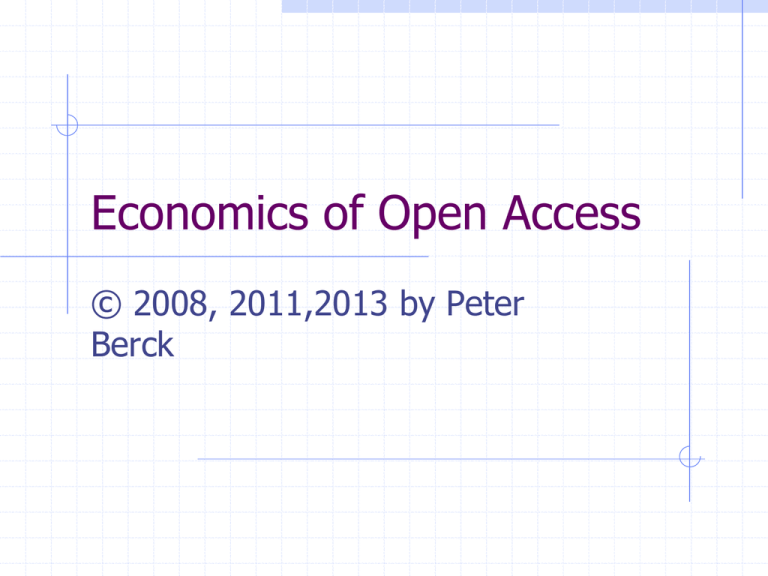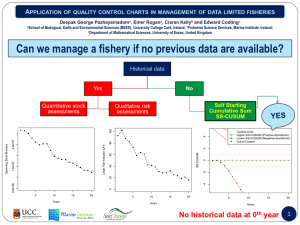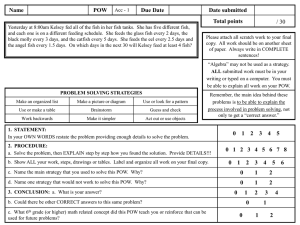Lecture in pptx is here - Agricultural and Resource Economics
advertisement

Economics of Open Access © 2008, 2011,2013 by Peter Berck Open Access: #1 Market failure in resource econ. Belongs to everyone and no-one. Good model for Atmosphere Many fisheries Poaching-Elephants Water in the west—everyone uses a little more and then is none left. Oil Fields Ground Water Mathematics seems covered well in Perman, chapter 17. Open Access-Fisheries the most notorious market failure The open access outcome Present value maximizing fishing rules Regulation by inefficiency Gear restrictions Time restrictions Regulation by quotas Where are the market failures? Fish in Sea Catching Fish Processing Fresh Consumer So What Is the Problem? Nothing strange about the consumer. Nothing strange about processing. Allocation between fresh and processed might be funny. Nothing strange about physical fishing process. Something very strange about fish in the sea. So What Should Fish Sell for? Price of fresh fish equals sum of: Marginal cost of transport and selling. Marginal cost of catching the fish. Shadow value of the fish in the sea. But fish in the sea aren’t sold! Lack of ownership is the principal problem. P – MCs –MCf = λ; but λ is zero because no one owns the sea λ = 0, so what? Because fish are free, take all you can get, right now. Leads to fish races and too much canning relative to fresh. Take all you can means too little breeding stock. A Typical Fishery History Starts with few fisherman Lots of fish Excellent catch Runs down the stock Fishers leave Catch collapses Stock (1000) metric tons North Sea Herring 3000 2500 2000 1500 1000 500 0 0 200000 400000 600000 800000 Harvest metric tons Source: Bjornal and Conrad North Sea Herring Number of Vessels 400 350 300 1969 250 1965 200 150 1976 100 50 1963 0 0 200000 400000 600000 800000 Catch (Metric Tons) Open Access The paperclip game. 10 people. 7 paper clips. 10 cents if picked up in first minute. 25 cents if picked up in second minute. What happens? If you have to pick them up with your mouth. Suppose there were transferable certificates entitling you to one clip. A Formal Model Open access vs. Present value maximizing The Schaefer Model x is biomass of fish in the sea h is the catch p is the price of fish E is the number of boats-years c is the cost of a boat-year Fish Per Boat When there are more fish in the sea it is easier to find fish. When there are more fish and one finds them, one catches more fish per unit of time. More fishing boats catch more fish. Catch h=kEx h is harvest E is trips x is biomass k is a constant Empirical formula that relates catch to trips and biomass Could generalize with a power of x Biology Stock next period = Stock this period Plus net growth (f(x) ) Growth Recruitment Less natural mortality Less catch dx/dt = f(x) - h Stock … MSY f(x)=gx(1-x/K) f(x) growth x stock Profits The profits from a boat are Price times Catch – Cost pkx–c When profits are positive, boats enter When negative, they leave So, in equilibrium profits are zero 2 Equation Model dE/dt = pkx –c dx/dt = f(x) - kEx Steady State When the stock does not change over time the fishery is said to have reached steady state. We will investigate steady states. When Stock Doesn’t Change The catch must be exactly the net growth. f(x) = k E x Steady state E(x) gx(1-x/K) = kEx E = (g/k)(1-x/K) How Can Profit Be Zero? The catch per trip depends upon the biomass of fish h/E=kx Lower biomass means less catch Profit = Zero pkx–c=0 xopen = c/(pk) Equilibrium in the E-x Plane E E = (g/k)(1-x/K) c/(pk) x Finding Eopen E = (g/k)(1-x/K) Eopen = (g/k)(1-c/(pkK) ) Recap… Since fishers will enter the fishery until profits are driven to zero, It must be the the steady state biomass of fish is such that the catch from a fishing trip just pays the costs of the trip. Catch and Cost: Steady State As Cost goes up the Catch rises and then falls F(x) growth and catch c/(pk) x stock Adjustment-the Phase Space The fishery is described by E and X Draw locus of E,X where E doesn’t change Draw locus of E,X where X doesn’t change Intersection is equilibrium Find direction of motion at all other places. Phase Space dx/dt = f(x) – kEx= 0 Is equation for one isocline We assume f is gx(1-x/K) E = f/(xk) is linear and downward sloping dE/dt = pkx – c=0 Is equation for other isocline It is vertical line at x = c/pk Direction of dE/dt When x > c/(pk) then dE/dt = pkx – c > 0 So arrow goes up dE/dt=0 E dx/dt=0 x Direction of dx/dt Start on dx/dt = f(x) – kxE Make E bigger Now dx/dt < 0 So above dx/dt=0 dx/dt < 0 dE/dt=0 E dx/dt=0 x Spiral or direct approach? dE/dt=0 The convergent. E dx/dt=0 x Approximating a diff eq We use Taylors theorem to find the values o f The system near the equilibrium Here f is just some function of z And f(z0) = 0 cause it is the equilibrium z f ( z ) f ( z 0 ) f '( z 0 ) z z 0 z z f '( z 0 ) N o te th at: z d ( z z0 ) so .. dt d ( z z0 ) dt f '( z 0 ) z z 0 Approx of dx/dt Find linear approx of system x x x gx (1 x / K ) kxE g (1 2 x * / K ) kE evalu ated at x *= c/(p k ) an d E ( x *) ( g / k )(1 x * / K ) x x g x * / K g c /( p kK ) Approx of dx/dt wrt E x gx (1 x / K ) kxE x E kx kc / ( pk ) Note that we evaluate at the equilibrium Approx of dE/dt E x E E E pkx c pk 0 Linear Approx to ODE x x0 gc / pkK E E0 pk c / p x x0 0 E E0 Soln of ODE’s z vector, A m atrix, C eigenvector eigenvalue constant A C = C by def of eigenvector/value . z Az t z (t ) e C is a soln. Eigenvalues g c / p kK g c / p kK 2 4 kc Two cases: real and negative Complex conjugate pair with negative real part. Lets look at e t Case 1: is negative and real. Then exp(t) goes to Zero as t goes to infinity Case 2: is complex conjugate pair with negative real part Recall (from 11th grade trig.) exp (it) = cos(t)+ i sin(t) re is the real part and imag is the imaginary part t e e re ( ) t e re ( ) t e im ag ( ) it cos im ag ( ) t i sin im ag ( )t Also goes to zero t e e re ( ) t e re ( ) t e im ag ( ) it cos im ag ( ) t i sin im ag ( )t So long as re(lamda) is negative. The sin/cos part leads to a circle- so you get a circle with ever smaller radius, aka a spiral. Soln of ODE’s with distinct eigenvectors, V1 and V2 Let a1 and a2 be constants in the complex field if the roots are complex x (t ) x0 1 t a1 e E (t ) E 0 V1 x 2t a2e V1 E V2 x V2 E And the RHS always goes to zero and x,E go to their equilibrium values. Either circling or directly inwards. Theory of ODE’s in plane Find the eigenvalues of the linear approx, call them 1 and 2 If they are real and negative then there is direct convergence to equilibrium If they are complex conjugate pair with negative real part, then there is a spiraling convergence to equilibrium Optimal management Suppose manager can control E directly and wishes to maximize PV of profits. How is this different from Open Access? Word on Hamiltonians R ules for current value H am iltonian: H , x , h ( w hatever is under the integral sign less the e + (R H S of the differen tial equation) 1. M ax h H 2. -r = 3. lim t e H x rt x 0 rt ) Simplest problem: necessary conditions m ax 0 h h phe rt s.t. x f ( x ) h and 0 x . dt 0 H ( h , , x ) ph ( f ( x ) h ) r H x f '( x ) m ax 0 h h H lim t e rt x 0 Solution From the max principle we see that H is linear in h, so either the control is “all the way on” or “all the way off” or it is exceptional. Lets start with the exceptional control. Exceptional Control So long as H p 0 Any value of h h will produce a maximum of H. Only interesting if this is true for more than an instant so d H dt h 0 0 r f '( x ) and 0 r f '( x *) So if x = x*, best policy is to keep it there, so h* = f(x*). Else drive it there as quickly as possible, so x > x*, all the way on. x< x*, all the way off. Finding the best policy for Schaefer m ax E e rz E pkx c dz 0 s .t . dx / dt f ( x ) kE x H ( x , E , ) pkE x cE ( f ( x ) kE x ) Present value Max principle r H x pkE f ' kE x f ( x ) kE x H E pkx c kx Most Rapid Approach Notice that H is linear in E (the control variable). Therefore to max H w.r.t. to E either E = infinite (ok, we choose an upper limit Eh) E = zero E = any and dH/dE = 0 We search for the exceptional control Where H E And stays zero. So pkx c kx 0 Eq. I d H 0 dt E p k x k x kx 0 Eq. II What does H E tell us? pkx c kx 0 p c / ( kx ) 0 Price of fish in market, less unit (and marginal) cost per fish caught, less shadow price of fish in the sea = 0. Or P = MC of catching plus MC of in situ resource How to find the exceptional control and its stock. Need to solve 4 equations to get rid of everything but constants and x. r 0 pkE f ' kE x f ( x ) kE x 0 pkx c kx pk x k x kx 0 Let’s find the exceptional value for x And compare it to xopen That’s your part of your homework! Part II of your homework is to run the matlab code fish2.m What happens as you increase step size? Choose one other parameter and find its effect of the simulation. Less Rigorous Thoughts Managing the Fishery Suppose the regulator can set effort directly ITQ’s: Individual Transferable Quotas Pacific Halibut Surf Clams How much quota? Lets leave time and interest out of the picture… Harvest = net growth k E x = F(x) or E = F(x)/(kx) If F is quadratic, then F(x)/(kx) is a downward sloping straight line E x What’s the best stock $ profit cE= cF/(xk ) Costs p F(x) Revenue xopen xstatic max biomass How to get there Raise Costs Done all the time Limit times one can fish Limit sizes one can catch throw back net size Limit gear sail boats only! number of hooks per foot Who Benefits… Raising costs means using more labor to catch the same amount of fish. Fishermen get employed Boat owners lose Raising costs implies higher yields than open access. Processors have more to process. They too are happy. Employment Year Fishers Processing and Wholesale Employment 1960 130,431 93,625 1980 193,000 103,448 1988 273,700 90,005 Taxes Lowering price received through taxes would also work. Not done. Doesn’t increase labor in fishery. Gives revenue to government, which does not create political support. The economics of time Previous model was too simple because it did not consider the economics of fish as a stock of capital. Let m be the price that should be charged for fish still in the sea. let d = 1/(1+r), where r is the interest rate. Again too simple This time ignore how the cost of catching fish varies with the number of fish in the sea. Suppose that one catches one less fish. One loses P the price of the fish The number of fish next year is increased by one fish + the progeny of the one fish Too simple… Before sparing the extra fish xt+1 = (xt ) + F(xt ) – Ht After sparing the extra fish xt+1 = (xt + 1) + F(xt + 1) – Ht Fact: F(xt + 1)- F(xt ) is approximately the derivative of the function F, F’ So sparing 1 fish results in 1+ F’ extra fish. F’ = r Rule 1+ F’ extra fish next year are worth p (1+F’)/(1+r) discounted to today An optimal policy is one which can not be improved by sparing one more (or less) fish so p = p (1+F’)/(1+r) F’(x) = r Regulation Short seasons drive up costs and protect the fish stock Seasons for Halibut were under two weeks Short season diverts fish from fresh to processed market Processors win Value of fishery declines markedly American Regulation Abysmal failure Fishers and Processors captured the Management Councils Councils set TAC so high that all fish stocks collapsed Minimal enforcement ITQ’s Are efficient. They create a property right in fish. Rights to Australian abalone were worth $500,000 per fisher Public was upset at transfer of property Get right distribution between fresh and processed Cut out those not historically in the fishery Why the Congressional Moratorium on ITQ’s Value of the rents. Decreased processing volume Will effectively lower catch and cause real pain today Real ITQ problems By Catch. Need to have guts to include all by catch in ITQ High Grading. Fishers throw back (and kill) fish that aren’t of high enough quality. Need to count all caught fish in ITQ. Need to spend real money to monitor.









